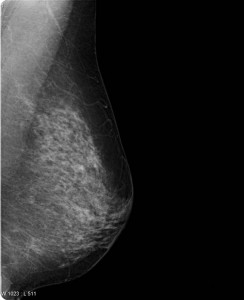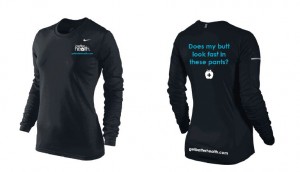November 26th, 2012 by Dr. Val Jones in Health Tips, Opinion, Research
5 Comments »
 A recent mammogram study in the New England Journal of Medicine was so controversial that the authors (Drs. Welch and Bleyer) decided to make a YouTube video to defend and explain their conclusions. Now that’s a first, isn’t it? Well kudos to the study authors for their creative approach to getting ahead of a controversy. However, their video (created for the “general public”) is still a bit too technical in my opinion. I’d like to take a crack at distilling it further.
A recent mammogram study in the New England Journal of Medicine was so controversial that the authors (Drs. Welch and Bleyer) decided to make a YouTube video to defend and explain their conclusions. Now that’s a first, isn’t it? Well kudos to the study authors for their creative approach to getting ahead of a controversy. However, their video (created for the “general public”) is still a bit too technical in my opinion. I’d like to take a crack at distilling it further.
A question on most women’s minds (as they turn 40 and beyond) is whether or not they should get a screening mammogram (x-ray of the breasts). If you have found a lump in your breast or you have a family history of breast cancer the answer is yes. No need to read any further. However, for the majority of us lumpless, family-history-free women, a screening mammogram is far more likely to expose us to unnecessary follow up testing than it is to catch a tumor early. Dr. Welch explains that screening mammograms aren’t very good at identifying aggressive breast cancer early enough to make a difference in whether one lives or dies anyway. That’s very disappointing news.
Dr. Welch goes on to explain that most of the gains we’ve made in breast cancer survival have been because of improved breast cancer treatments, not because of early detection with mammograms. He estimates that every year in the U.S. 1.3 million women are “over-diagnosed” with breast cancer because of screening mammograms, subjecting women to unnecessary biopsies, surgical procedures, and further follow up studies. In the video, Dr. Welch doesn’t explain exactly what these “over diagnosed” cancers end up being exactly (Cysts? Benign calcifications? Early non-aggressive cancers that the immune system kills on its own?) But suffice it to say that they don’t contribute to the cancer death rates.
So, given the fact that you are more likely to suffer through a false alarm than to discover a cancer early (and even if you do find it early, if it’s the “bad” kind you may not survive) are you willing to undergo a screening mammogram? That’s a personal question that we each have to answer for ourselves. As time goes on, however, I suspect that the answer will be made for us since health insurance companies (whether public or private) will begin to balk at paying for tests that do more harm than good overall. I think this issue is really at the heart of the controversy (the perception of rolling back a health benefit that women currently “enjoy”). Eventually screening mammograms may become an out-of-pocket expense for women who simply prefer the peace of mind that a normal test can give – even at the risk of going through a false alarm.
That being said, it sure would be great if we could find a screening test that identifies breast cancer early – especially the aggressive kind. Perhaps a blood test will do the trick one day? At least it is comforting to know that we have made great strides on the treatment side, so that fewer women than ever before die of breast cancer. More research is needed on both the screening and treatment sides of course.
As for me, I do regular breast self exams – though because I have no family history of breast cancer I’ve opted out of screening mammograms because I feel the cost/benefit ratio is not in my favor. I certainly hope that a better screening test is developed before I face a potential diagnosis. I respect that other women will disagree with me – and I think they have the right to be screened with the only option we currently have: the mammogram. I’m not sure how long it will continue to be covered by insurance, but at a price point of about $100, most of us could still afford to pay for it out-of-pocket if desired.
The bottom line of this controversial research study is that screening mammograms don’t actually catch death-causing breast cancers early enough to alter their course. Even though it makes intuitive sense to be screened, long term observations confirm that overall, mammograms do more harm than good. So now we wait for a better test – while some of us continue with the old one (as the National Cancer Institute recommends), and others (like me) don’t bother.
***
Thanks to ePatient Dave and Susannah Fox who brought the issue to my attention on Facebook. Isn’t social media grand?
November 26th, 2012 by admin in Quackery Exposed, True Stories
No Comments »
 What did the jockey who never lost a race whisper into the horse’s ear? “Roses are red, violets are blue, Horses that lose are made into glue!” OK, so it’s a groaner. But until the advent of polyvinyl acetate (PVA) and other synthetic glues in the twentieth century, the destiny of aging horses was indeed the glue factory. The collagen extracted from their hides, connective tissues and hooves made for an ideal wood adhesive. Our word “collagen” for the group of proteins found in these tissues actually derives from the Greek “kolla” for “glue.”
What did the jockey who never lost a race whisper into the horse’s ear? “Roses are red, violets are blue, Horses that lose are made into glue!” OK, so it’s a groaner. But until the advent of polyvinyl acetate (PVA) and other synthetic glues in the twentieth century, the destiny of aging horses was indeed the glue factory. The collagen extracted from their hides, connective tissues and hooves made for an ideal wood adhesive. Our word “collagen” for the group of proteins found in these tissues actually derives from the Greek “kolla” for “glue.”
Not all aging horses were dispatched to the glue factory after their plow-pulling days came to an end. Some farmers found they could squeeze a little more profit out of the animals by assigning them another duty. They would become leech collectors! The elderly horses were driven into swampy waters only to emerge coated with the little bloodsucking worms. It seems the creatures found horses to be a particularly tasty treat! Since for many people suffering from various ailments, the little parasites were just what the doctor ordered, the harvesting of leeches made for a lucrative business.
Leeches have actually been used in medicine since they were first introduced around 1500 BC by the Indian sage Sushruta, one of the founders of the Hindu system of traditional medicine known as “Ayurveda.” That translates from the Sanskrit as “knowledge of life.” Sushruta recommended that leeches be used for skin diseases and for various musculoskeletal pains. Ancient Egyptian doctors extended the indications, treating headaches, ear infections and even hemorrhoids in this peculiar fashion. Galen, the famous Roman physician, used leeches to balance the four “humors,” namely blood, phlegm, black bile and yellow bile. Swollen, red skin, for example, was thought to be due to too much blood in the body and the answer was to have leeches slurp the excess.
Curiously, despite having no evidence for efficacy, bloodletting, either with leeches or by making an incision with a “lancet,” became part of standard medical practice for more than 2500 years! Monks, priests and barbers got into the act along with physicians. In 1799 George Washington had more than half his blood drained in ten hours, certainly hastening his demise.
Many British doctors preferred leeches, especially in areas around the mouth, ears and eyes where lancing was a tricky procedure. They even learned how to encourage a leech to bite by stimulating its appetite with sugar or alcohol. But the creatures were in short supply, and had to be imported by the millions from France, Germany, Poland and Australia where they were often caught in nets using liver as bait. Sometimes poor children earned a little extra money by wading into infested waters to emerge, like the horses, with leeches attached to their legs. A gentle tug or a pass with a flame then relaxed the bloodsucker’s grip before much damage ensued. Good thing, because leeches can be pretty nasty once they latch on. Remember Humphrey Bogart flailing about in African Queen while trying to rid himself of the little vampires?
The lack of leeches caused some physicians to explore recycling techniques. Usually a single leech becomes satiated after filling up on about 15 milliliters of blood and then falls off. But then if it is plunked into salt water, it will disgorge the blood and is soon ready for another round. A German physician even developed a technique to encourage continued sucking by making an incision in the leech’s abdomen allowing for the ingested blood to drain out as fast as it came in. It seems the leech wasn’t much bothered by this affront to its belly and would go on sucking for hours. Amazingly, leeches were sometimes used internally. To treat swollen tonsils, a leech with a silk thread passed through its body would be lowered down the throat and withdrawn when it had finished its meal. Sometimes the creatures were even introduced into the vagina to treat various “female complaints.” The literature is vague about how this was done but one account suggests that the technique required a clever nurse.
While bloodletting as a general treatment for ailments has been drained out of the modern medicine chest, there is still work for leeches. That’s because their saliva is a complex chemical mix of pain killers and anticoagulants. Hirudin, for example, is the protein that keeps the blood flowing steadily after the initial bite is made, and is so effective that the blood will not coagulate for quite some time even after the leech falls off. Indeed, these bloodsucking aquatic worms have received approval from the U.S. Food and Drug Agency as a “medical device.”
Surgeons have been known to use leeches after reattaching ears, eyelids or fingers that have been severed, as well as after skin grafts. This has to do with the fact that arteries are easy to reconnect but veins are not. Eventually new capillaries do form to reconnect veins, but in the meantime the finger or ear fills with blood which then clots and causes problems with circulation. A leech will drain the excess blood at just the right rate and can prevent blood clot formation by injecting hirudin. This is such a potent anticoagulant that it holds hope for dissolving blood clots after a heart attack or stroke. Unfortunately hirudin is too difficult to extract from leeches but can potentially be produced through genetic engineering techniques.
Where do physicians get leeches today? No need for horses. They can order them directly from the French firm Ricarimpex. One would think that after helping to save a finger or an ear the useful little critters would be rewarded. But their destiny is death in a bucket of bleach. Not any better than ending up in a glue factory.
***
Joe Schwarcz, Ph.D., is the Director of McGill University’s Office for Science and Society and teaches a variety of courses in McGill’s Chemistry Department and in the Faculty of Medicine with emphasis on health issues, including aspects of “Alternative Medicine”. He is well known for his informative and entertaining public lectures on topics ranging from the chemistry of love to the science of aging. Using stage magic to make scientific points is one of his specialties.
November 21st, 2012 by Dr. Val Jones in Health Policy, Opinion
No Comments »
 In a recent post entitled, “The Joys Of Health Insurance Bureaucracy” I described how it took me (a physician) over three months to get one common prescription filled through my new health insurance plan. Of note, I have still been unable to enroll in the prescription refill mail order service that saves my insurer money and (ostensibly) enhances my convenience. The prescription benefits manager (PBM) has lost three of my physician’s prescriptions sent to them by fax, and as a next step have emailed me instructions to complete an online form so that they have permission to contact my physician directly (to confirm the year’s refills). Unfortunately, page one of the form requires you to fill in your drug name and match it to their database’s list before you can continue to page two. For reasons I can’t understand, my common drug is not in their database. Therefore, I am unable to comply with my insurer’s wish that I enroll in mail order prescription refills. This will further delay receipt of my medication – and probably increase my cost as I will be penalized for not opting into the “preferred” mail order refill process.
In a recent post entitled, “The Joys Of Health Insurance Bureaucracy” I described how it took me (a physician) over three months to get one common prescription filled through my new health insurance plan. Of note, I have still been unable to enroll in the prescription refill mail order service that saves my insurer money and (ostensibly) enhances my convenience. The prescription benefits manager (PBM) has lost three of my physician’s prescriptions sent to them by fax, and as a next step have emailed me instructions to complete an online form so that they have permission to contact my physician directly (to confirm the year’s refills). Unfortunately, page one of the form requires you to fill in your drug name and match it to their database’s list before you can continue to page two. For reasons I can’t understand, my common drug is not in their database. Therefore, I am unable to comply with my insurer’s wish that I enroll in mail order prescription refills. This will further delay receipt of my medication – and probably increase my cost as I will be penalized for not opting into the “preferred” mail order refill process.
Now, all of this is infuriating enough on its own, but the larger concern that I have is this: How many patients are not “compliant” with their medication regimen because of problems/delays with their health insurer or PBM? Physicians are being held accountable for their patients’ medication compliance rates, even receiving lower compensation for patients who don’t reach certain goals. This is called “pay-for-performance” and it’s meant to incentivize physicians to be more aggressive with patient follow up so that people stay healthier. But all the follow up in the world isn’t going to get patient X to take their medicine each day if their health insurer or PBM makes it impossible for them to get it in the first place. And shouldn’t there be consequences for such excessive red tape? Who is holding the insurers and PBMs accountable for their inefficiencies that prevent patients from getting their medicines in a timely manner?
Pay-for-performance assumes that physicians are the only healthcare influencers in the patient compliance cycle. I’ve learned that we only play a part in helping people stay on the best path for their health. Other key players can derail our best intentions, and it’s high time that we look at the poor performance of health insurers and PBMs as they often block (with intentional bureaucracy) our patients from getting the medicine they need. While insurers save money by having patients struggle to get their prescriptions filled, doctors are payed less when patients don’t take their medicines.
Not a great time to be a doctor or a patient… or both.
November 20th, 2012 by Dr. Val Jones in Announcements, Humor
1 Comment »

Does my butt look fast in these pants?
Since I started running (in earnest) a couple of years ago, I’ve been doing what I can to stay motivated. Running is a great sport because 1) it’s cheap 2) you can do it anywhere 3) it’s hard. So, because of #3 I welcome all opportunities to make running fun – and wearing amusing shirts during races seems like as good a strategy as any.
The idea for the “Does my butt look fast in these pants?” shirt came from a sign I saw at a recent marathon. A guy was cheering on the ladies with a homemade sign that read: “Your butt looks fast in those pants!” I laughed so hard it took me a quarter mile to recover. So I shamelessly stole his idea and made a Better Health women’s running shirt out of it. If you think it’s cool and want one too – I’d be happy to print you one. The larger the batch we order, the less expensive it will be.
So if you’re looking for a funny Christmas gift… or if you just want to thwart the race competition by making it impossible for them to pass you without sputtering out a laugh, let me know. Email me if you’d like to order a shirt and we’ll discuss details. My email is: val.jones@getbetterhealth.com (They are made of Nike dry-fit fabric, come in the colors shown only, and are available in Ladies S, M, L – if guys show interest I suppose we could order a run of men’s shirts too?). Let’s prepare to GET BETTER HEALTH this season… and run our way to victory in the battle of the bulge. 😆
November 19th, 2012 by Dr. Val Jones in Announcements
No Comments »

Tina Thompson, Mario Lopez, Dr. Val Jones
The Boys & Girls Clubs of America (BGCA) are about to kick off their annual Fit Family Challenge. The goal is to support families as they commit to a lifestyle of healthy diet, regular exercise, and strong moral qualities. It’s called the “Triple Play” approach – a game plan for body, mind, and soul. I’m honored to be their “mind” coach again this year, and will help to shepherd 250 BGCA families from across the country. Five finalists will be chosen to compete in Los Angeles for the title of fittest family near the end of 2012. We have timed the competition to coincide with New Year’s Resolution planning, and hope that these fit families will inspire others to turn over a new leaf in 2013.
As part of my support for the competition, I’ll be publishing several blog posts (at Better Health and the Fit Family Challenge Blog) with evidence-based healthy eating tips for the families – and for anyone who wants to follow along with the Triple Play Fit Family Challenge. I can’t wait to see how lives will change – and how together we can tip the scales against obesity, disease, and unhealthy relationships. Please join the Boys & Girls Clubs in this important initiative.
 A recent mammogram study in the New England Journal of Medicine was so controversial that the authors (Drs. Welch and Bleyer) decided to make a YouTube video to defend and explain their conclusions. Now that’s a first, isn’t it? Well kudos to the study authors for their creative approach to getting ahead of a controversy. However, their video (created for the “general public”) is still a bit too technical in my opinion. I’d like to take a crack at distilling it further.
A recent mammogram study in the New England Journal of Medicine was so controversial that the authors (Drs. Welch and Bleyer) decided to make a YouTube video to defend and explain their conclusions. Now that’s a first, isn’t it? Well kudos to the study authors for their creative approach to getting ahead of a controversy. However, their video (created for the “general public”) is still a bit too technical in my opinion. I’d like to take a crack at distilling it further.


 In a recent post entitled, “
In a recent post entitled, “









